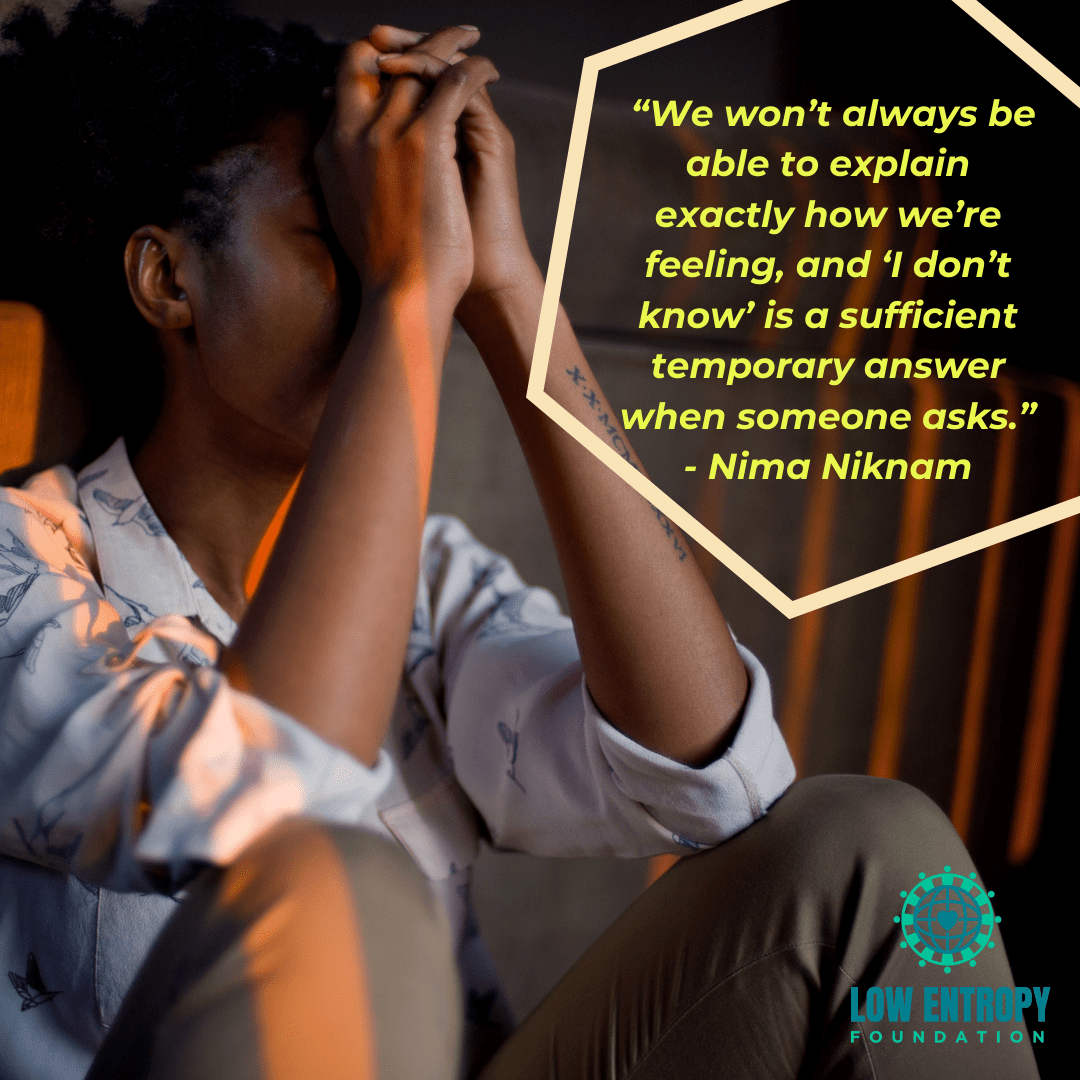
How do we communicate what we are feeling? Low Entropy Volunteer Writer Nima Niknam offers insight into navigating the complexity of difficult emotions that are difficult to describe.
Have you ever sat on your couch or your bed feeling down and wondering why you’re feeling that way? Do you try to analyze how you’re feeling and then realize that you don’t know what’s bothering you? Do you find that in these moments you have trouble pinpointing what emotions you’re feeling? Your roommate might tell you that you don’t look yourself and might ask you what’s wrong. When you go to respond, you have no idea how to answer because you don’t know what’s bothering you.
If you’re like me, then you’ve experienced this before. It’s a strange experience, one that leaves you feeling not quite yourself. You have no idea what it is you feel, or how to describe how you’re feeling. You just feel off.
Sometimes, I’ll find myself sitting in a chair, not doing anything, feeling like I don’t want to do anything. I know something is bothering me, but I’m not sure what it is. I don’t know if what I’m feeling is due to something I experienced that day, or if it’s something that happened days or weeks ago. I’ll find myself at a loss of words.
So, what does this mean? Is there an answer to this? An easy explanation for what you’re feeling? The quick answer to this is no. Everyone is different, and what we may be feeling will not be the same as what someone else is feeling.
But how do we determine what it is we’re feeling? In my experience, the reason we have trouble describing how we’re feeling when we’re feeling this way is often because we are experiencing a range of emotions that make it hard to decipher which emotion is specifically bothering us. If you’re feeling sad, you may also be feeling anger, regret, guilt, frustration, disappointment, etc. So when we have trouble describing to our roommate how we’re feeling, it could be that it’s because we have seven different emotions and/or feelings that are working in tandem. Feeling a combination of emotions can make it quite difficult to pinpoint specifically which emotion is the main culprit and why that emotion is the one that’s impacting you the most.
For example, think of a scenario in which your friend says something bad about you behind your back. You find out from a third party what she said and instantly you start to feel upset. But not only do you feel upset, you also feel angry, disappointed, devastated or afraid that you may have lost a friend, etc. Later, when you sit on the couch feeling confused and conflicted and are having trouble discovering what it is that’s bothering you about your friend, it’s likely that you have a combination of emotions or feelings that are working with each other. And because of that, you don’t know which emotion is the one that is bothering you the most.
We, as humans, experience emotions all the time. It is in our nature to feel. What I’ve learned from these experiences is to not get frustrated by not having all the answers. We won’t always be able to explain exactly how we’re feeling, and “I don’t know” is a sufficient temporary answer when someone asks. It may not feel that way because someone may give you a look after you give them that response, or you may feel like you didn’t give them a proper answer. But if we don’t know what we’re feeling ourselves, then we can’t tell someone else how we’re feeling.
So how do we get down to what emotion we’re feeling the most? Honestly, my tip is to get down to what caused us to feel this way. Was there a specific incident or moment that occurred that left us in this position? After discovering the incident, we can look at our feelings like a checklist. Do we feel angry? No, it’s not anger. Do we feel sad? A little bit, but it’s not quite sadness we’re feeling. Do we feel guilty? We pause. Yes, guilt sounds correct. By going through the checklist strategy, we can start to unravel the main feeling or emotion that was the one that was impacting us the most.
Often, it is natural for us to experience several emotions at once, especially if they are similar. But in my experience, when we have trouble explaining or understanding how we’re feeling, it’s likely because we are experiencing multiple emotions at once. By going through the checklist, we can get to the heart of how we’re feeling.
If you’re looking for a place where you can figure out your emotions, Low Entropy offers gatherings where active listening is the order of the day. With a diverse community of compassionate individuals, we might be able to help you sort out that pile of feelings, if only just a little bit.

Thanks Nima for this great article. I really love the angle of having a checklist to verify the root cause of whatever issues one is going through, but even when that is still a challenge, you always have a listening ear in Low Entropy.
Going by the popular saying, a problem shared is a problem solved. One thing is assured when you connect with us and that is, you will definitely feel lot better.